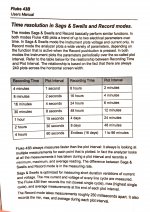The PQM set to record for 8 minutes has plot interval of 2 seconds. The record mode takes measurements roughly 250 milliseconds apart. It records the min, max and avg during each plot point. I attached a photo of the manual explaining the time resolution.
Each plot point (every 2 seconds) showed a min current less than 1 amp and a max above 15a during the the agitation cycle.
My lights pulse with the rhythm of the agitator. The motor starts and stops with each change of direction so it’s possible I'm seeing the inrush current every time the motor starts.
My hesitation with your test is that 15w incandescent produces 300 lumens while a 9w led produces 800 lumens. So not the same brightness which I believe plays a factor in it being noticeable. I have a 40w incandescent light bulb. I can place it on the nonloaded side tomorrow.
Thanks again.
Each plot point (every 2 seconds) showed a min current less than 1 amp and a max above 15a during the the agitation cycle.
My lights pulse with the rhythm of the agitator. The motor starts and stops with each change of direction so it’s possible I'm seeing the inrush current every time the motor starts.
My hesitation with your test is that 15w incandescent produces 300 lumens while a 9w led produces 800 lumens. So not the same brightness which I believe plays a factor in it being noticeable. I have a 40w incandescent light bulb. I can place it on the nonloaded side tomorrow.
Thanks again.



